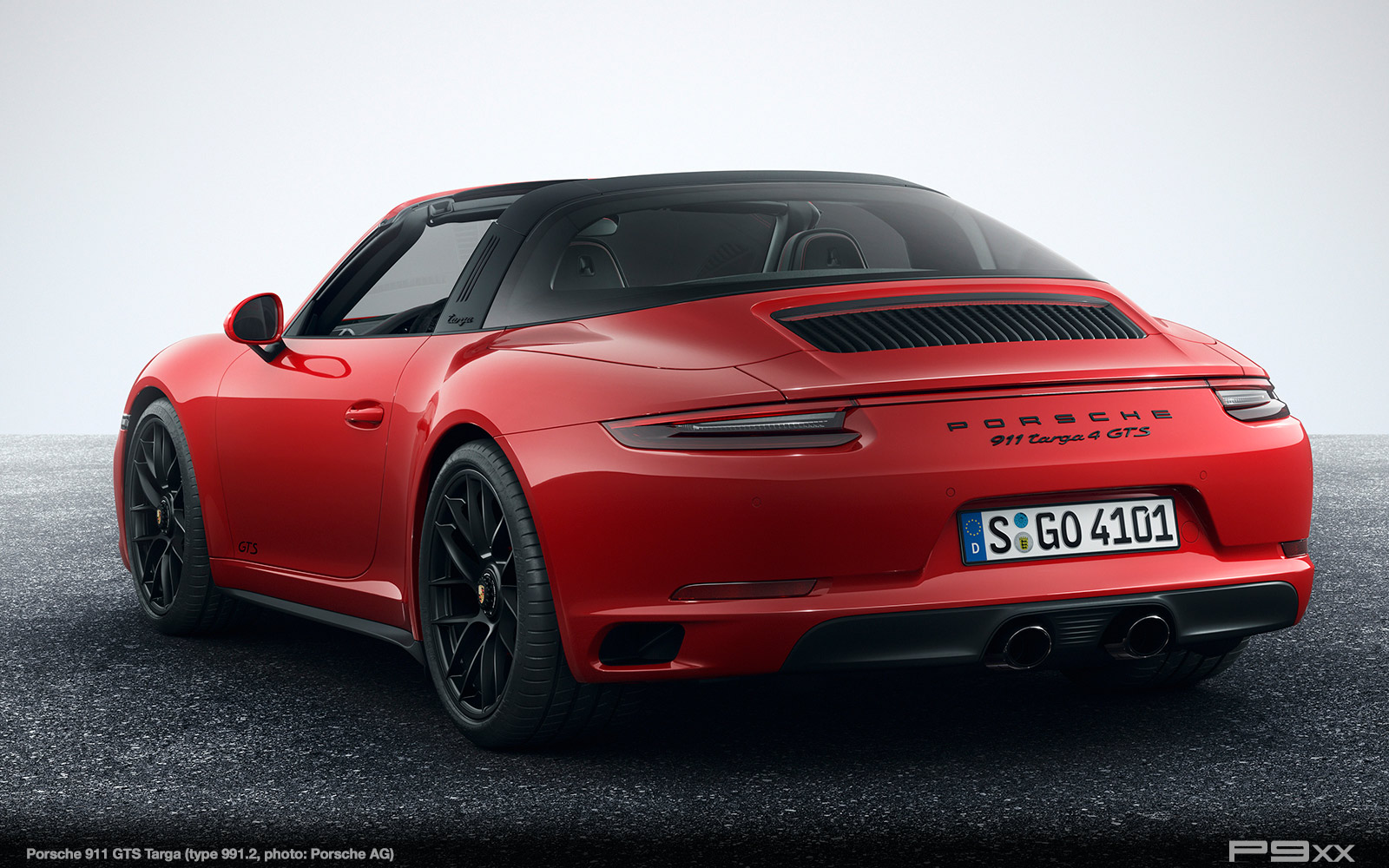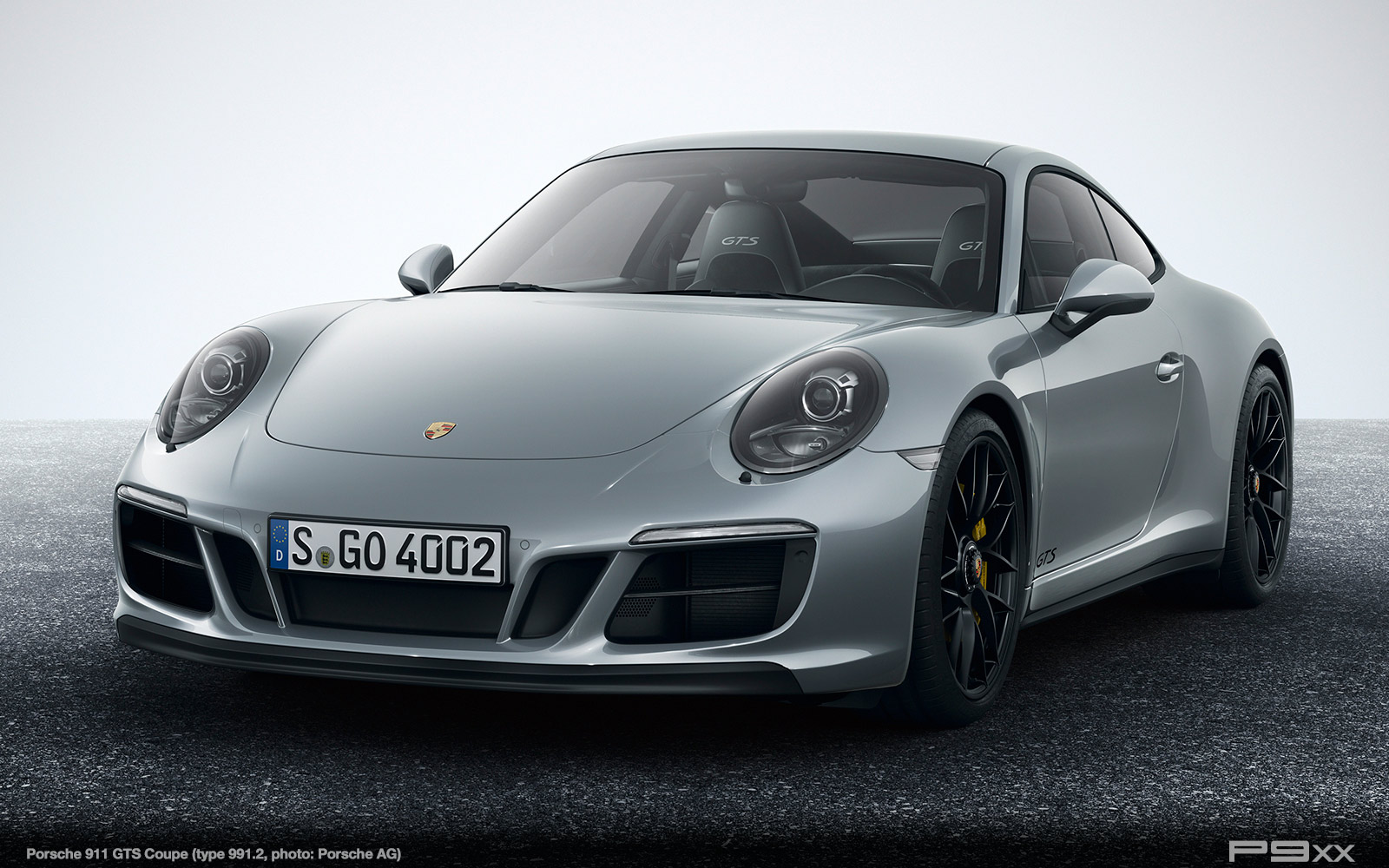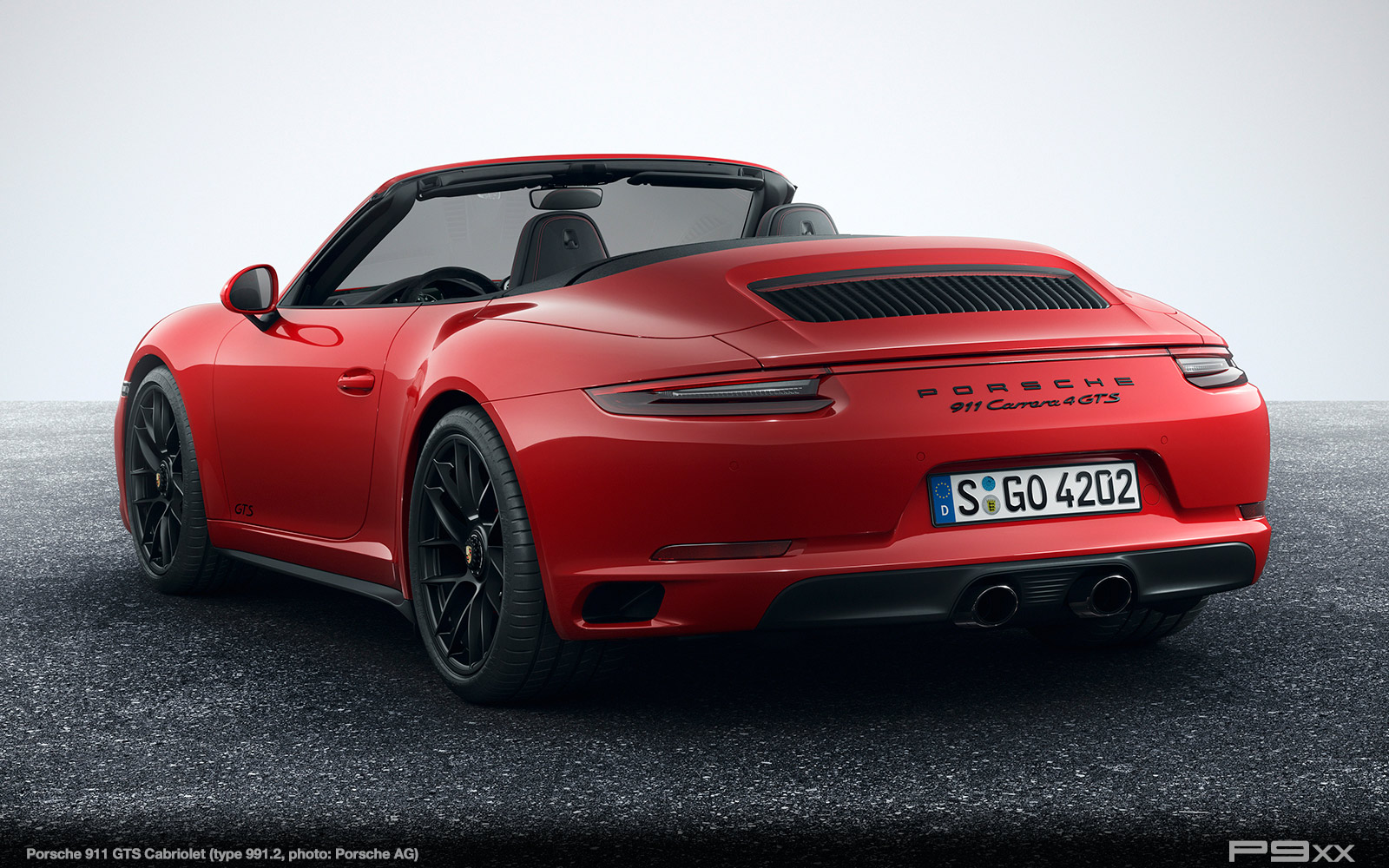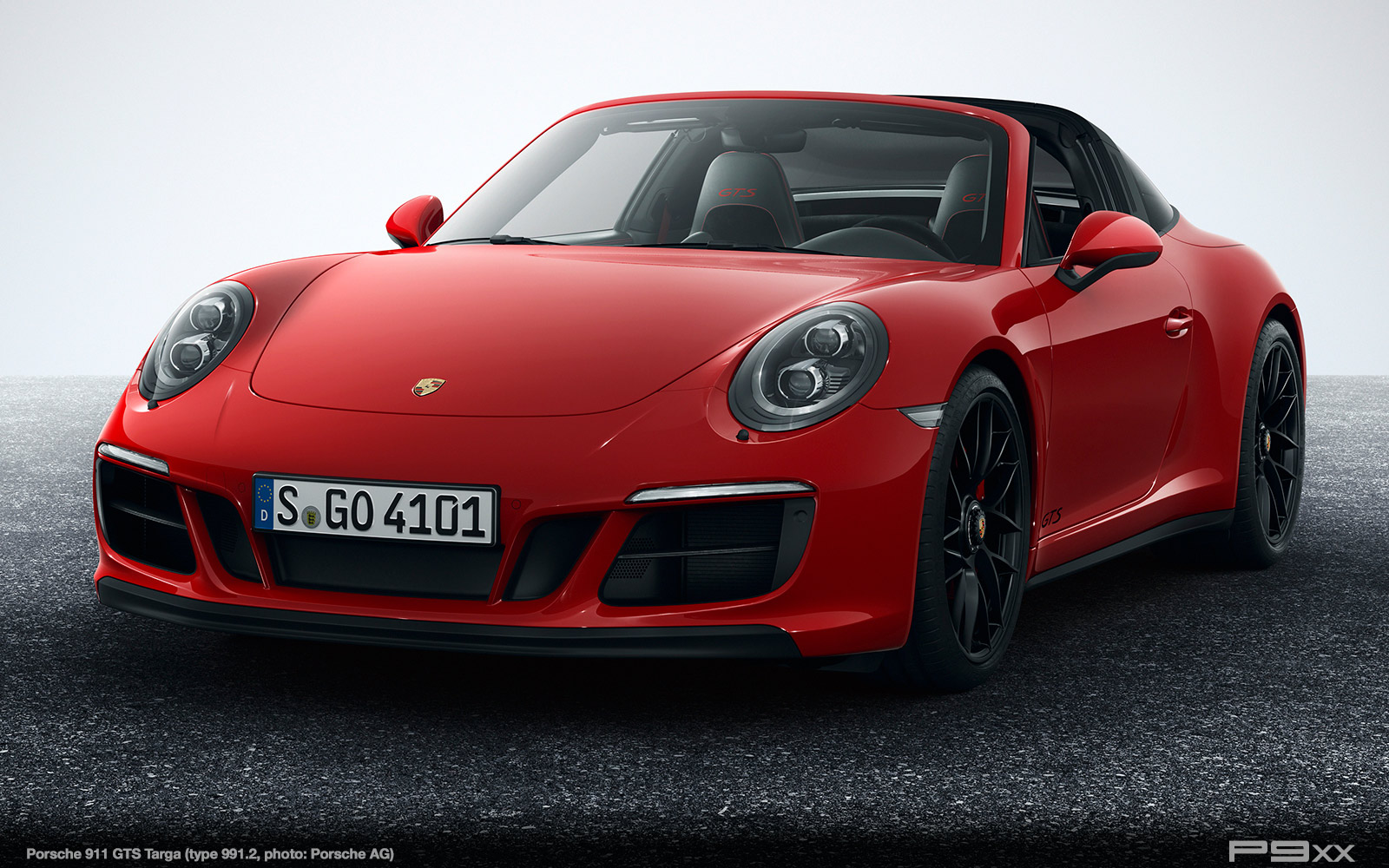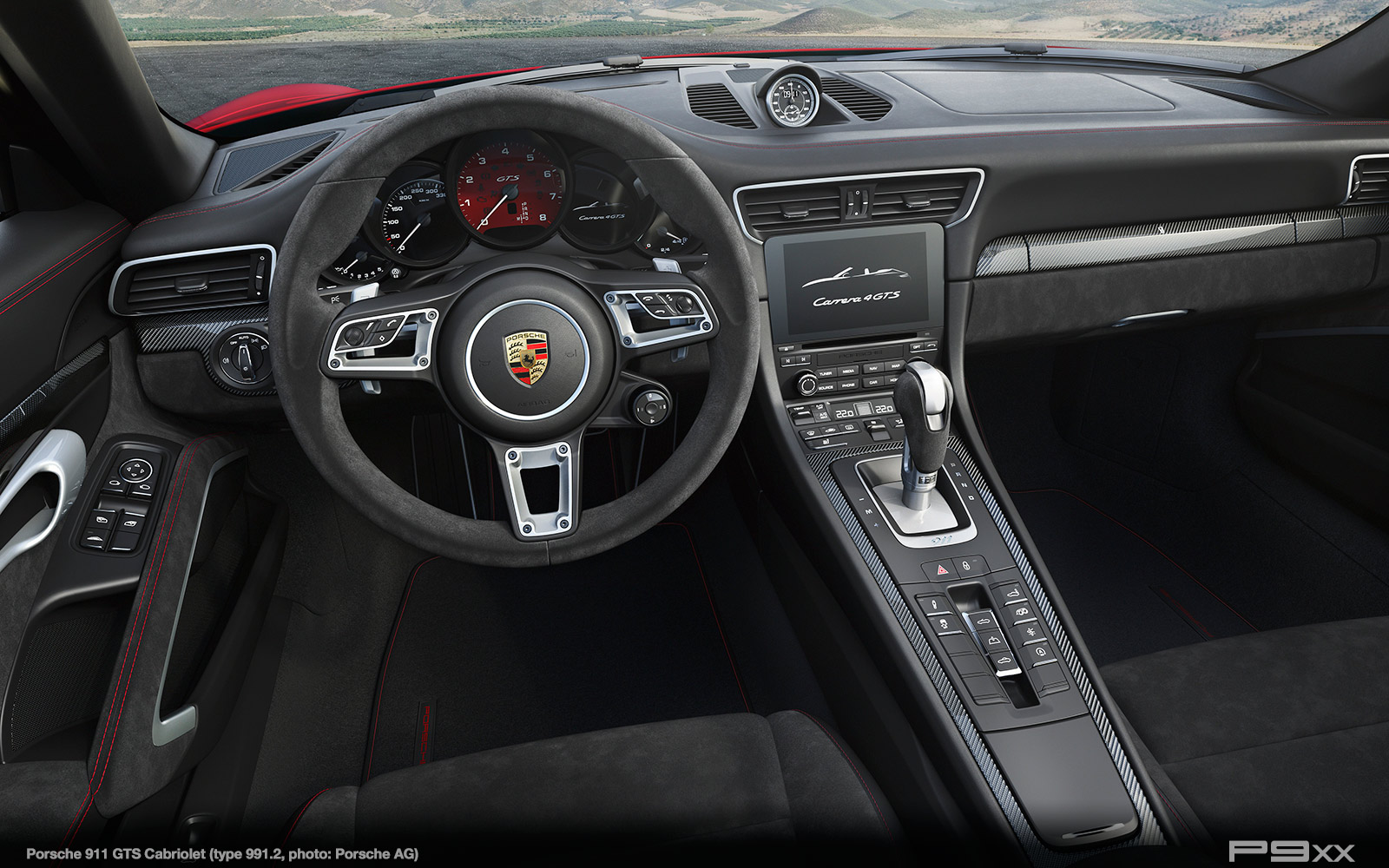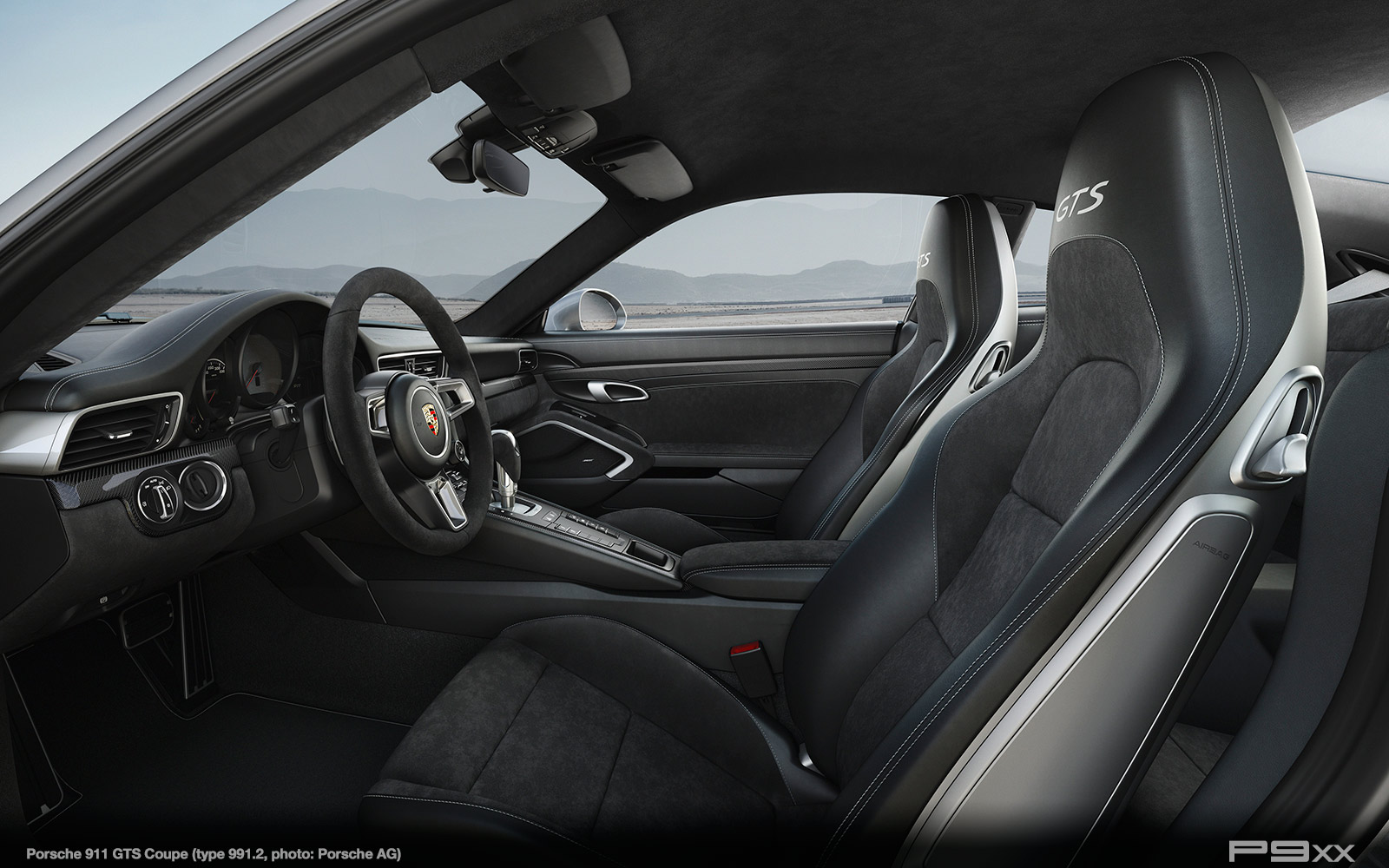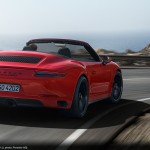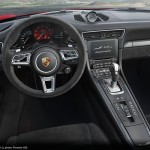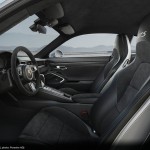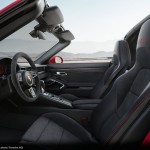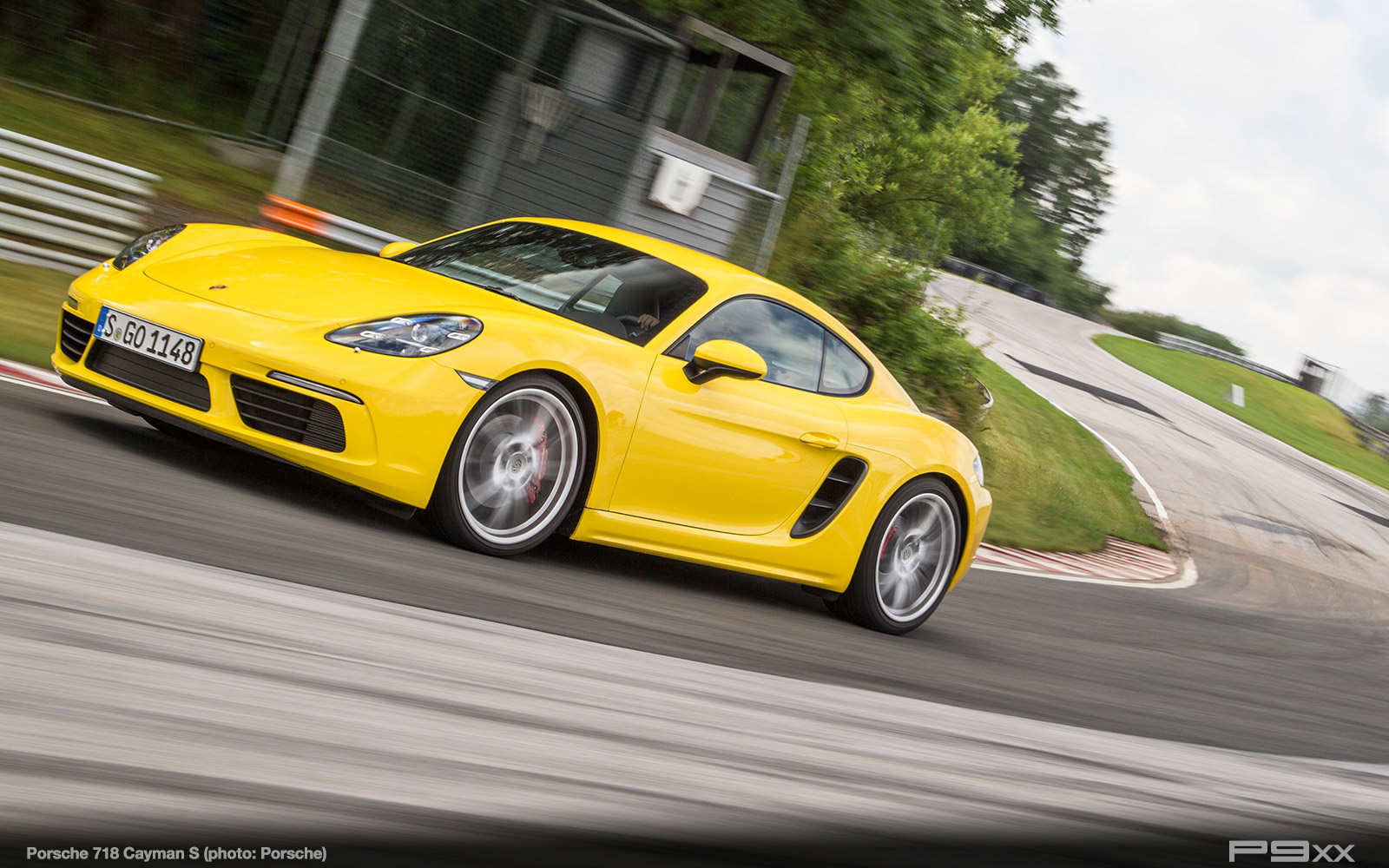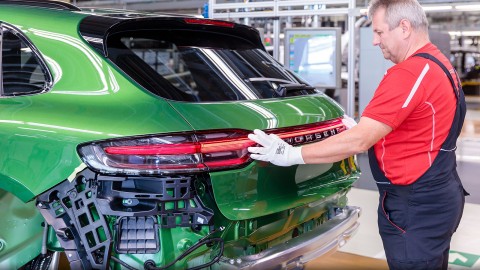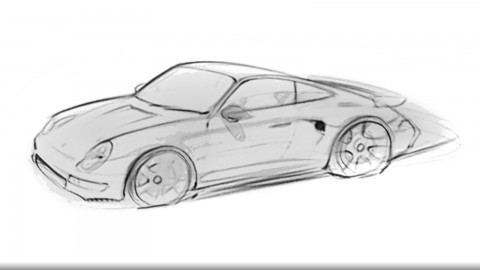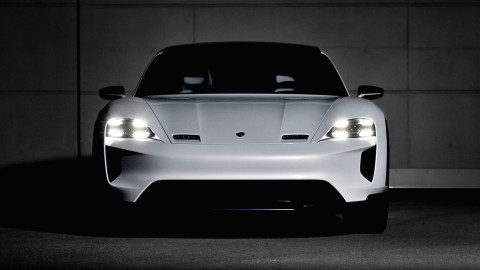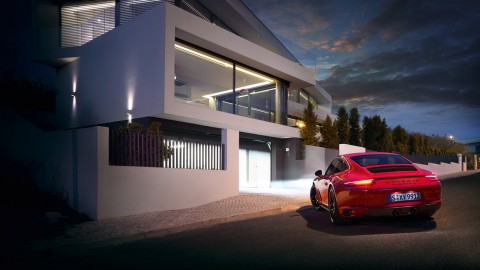Summary
True to the GTS Porsche spirit, the new 911 GTS models provide even greater performance and efficiency. Five variants are available in total: the 911 Carrera GTS with rear-wheel drive, the 911 Carrera 4 GTS with all-wheel drive – both of the above available as a Coupé and Cabriolet – and the 911 Targa 4 GTS. The newly developed turbochargers for the three-litre, flat-six engine give the sportscars a performance boost of 22 kW (30 hp) compared to the current 911 Carrera S models (and 15 kW (20 hp) compared to the previous GTS model with naturally aspirated engine). All models are available with a manual seven-gear transmission or optional Porsche Doppelkupplung (PDK).
| Drive | The three-litre, six-cylinder bi-turbo flat engine with newly developed turbochargers develops 331 kW (450 hp). The maximum torque of 550 Nm is achieved between 2,150 and 5,000 rpm. |
| Performance | The new 911 Carrera 4 GTS Coupé with Porsche Doppelkupplung (PDK) and Sport Chrono Package sprints from zero to 100 km/h in 3.6 seconds. For the rear-wheel-drive 911 Carrera GTS Coupé with manual transmission, the top speed is now 312 km/h. Fuel consumption is lower than the prior models with naturally aspirated engines by up to 0.6 l/100 km. |
| Chassis | The wide Carrera 4 body also gives each GTS model a 44 mm broader track width across the rear axle. This reduces lateral body movement and provides even better cornering stability. As standard, the GTS is equipped with 20-inch centre lock wheels painted in silky black, derived from the 911 Turbo S. The sports chassis with Porsche Active Suspension Management (PASM) lowers the body of the GTS Coupés by ten millimetres compared to the 911 Carrera S (-20mm total). The Sport Chrono Package is fitted as standard equipment on all GTS vehicles. Optional rear-axle steering improves handling while providing even greater stability at higher speeds. |
| Design & aerodynamics | The new SportDesign front apron gives the GTS a look distinct from other Carrera and Targa models. The aerodynamically optimised front end with low front spoiler and higher rear spoiler extension reduce the lift forces on the front and rear axle. At the rear, smoked tail light lenses, black logos, air intake grille and a central black exhaust tailpipe make the GTS unmistakable. The rear-wheel drive models are further set apart from the C4 versions by a black trim strip instead of a light strip between the tail lights. SportDesign exterior mirrors and centre lock wheels painted in silky black complete the side view. For the first time, the 911 Targa 4 GTS also features a black Targa roof bar as standard. |
| Sound | A sports exhaust system as standard and reduced sound absorption in the pipes provide the characteristic GTS sound. |
| Interior | Sporting ambience in the cockpit: GTS passengers sit on Alcantara sports seats with a new stitching pattern. The interior trim strips are made from brushed aluminium with a black anodised finish. The steering wheel rim, centre console and armrests are trimmed with Alcantara. As an option, the rear seats in the Coupé can be removed to save even more weight. |
| Infotainment | The Porsche Communication Management (PCM) system with touchscreen is operated as easily as a smartphone. It features the new Porsche Track Precision app as standard, which can be used in all GTS models for the first time. This enhancement from the world of motorsport allows automatic recording, detailed display and analysis of driving data on a smartphone. |
Five New GTS Models. Five Times the Power. A sporting new addition to the 911 family.
The five new GTS derivatives are the most sporting and most emotional entries in the 911 Carrera/911 Targa model line. They are designed specifically for 911 drivers wishing for even greater sporting dynamics, who nonetheless value a car suitable for everyday use. In addition to performance-orientated features, the GTS models boast a high trim level.
The 904 Carrera GTS first brought motorsport technology to the streets as a road-approved sportscar back in 1963. The 924 GTS and 928 GTS that followed refined this principle throughout the 1980s and 1990s. In 2010, the GTS celebrated its rebirth in the form of the 911 Carrera GTS (Type 997). Since then, a total of 15,334 GTS models of the iconic 911 sportscar have been sold to customers.
Performance and Engine. New turbocharger provides more power.
At the heart of every Porsche lies its engine. The rear end of the new 911 GTS models houses a three-litre, six-cylinder biturbo flat engine with 331 kW (450 hp). The maximum torque of 550 Nm is achieved between 2,150 and 5,000 rpm. The engine delivers 22 kW (30 hp) more than the 911 Carrera S (and 15 kW (20 hp) more than the corresponding GTS predecessor model with naturally aspirated engine).
This increase in power is thanks to newly developed turbochargers and a higher boost pressure, all of which results in improved torque characteristics, faster acceleration and an even higher top speed. All 911 GTS models accelerate from zero to 100 km/h at least 0.2 seconds faster than the current S models. The first to reach this speed is the 911 Carrera 4 GTS Coupé with PDK in Sport Plus mode, which hits the mark in just 3.6 seconds. And all GTS models feature a top speed in excess of 300 km/h. The Coupé with manual transmission and rear-wheel drive boasts the highest top speed at 312 km/h (four km/h more than the comparable S model).
But that’s not all: the great acceleration and sprinting qualities of the GTS are combined with excellent cornering dynamics. The 911 Carrera GTS completed the 73 corners and 20.83 kilometres of the Nürburgring Nordschleife in just 7:26 minutes on standard road tyres. This is twelve seconds faster than its predecessor and four seconds faster than the current 911 Carrera S.
Alongside the introduction of the GTS models, Porsche is also offering new, road-approved UHP (ultra-high performance) sports tyres designed specifically for the racing circuit. With a tyre compound, tyre profile and profile depth tailored specifically to high performance, these tyres are available from Porsche Centres for all current 911 models. The UHP tyres allow drivers to maintain consistently fast lap times for longer on the race track. Equipped with these tyres, the GTS lapped the Nürburgring Nordschleife an additional four seconds faster. The tyres on the front axle measure 245/35 x ZR20, and on the rear axle 305/30 x ZR20.
However, the performance of a GTS is not dictated by sheer power alone, but also by its engine sound. The sports exhaust system with centrally positioned black tailpipes lends the flat engine an inimitable sonorous tone. A throaty growl when accelerating into the rev-limiter and the short bursts from the automatic throttle-blip function in Sport and Sport Plus mode further accentuate the typical 911 sound. The specially aligned interplay of engine and exhaust flap control, coupled with reduced sound absorption, give the GTS models an even more emotional note. This distinctive sound further underlines the vehicle’s character.
However, the GTS remains true to the Porsche ethos of intelligent performance. Despite its high power, the 911 Carrera GTS with PDK, for example, consumes only 8.3 l/100 km according to the NEDC. This corresponds to CO2 emissions of 188 g/km.
All 911 GTS models feature seven-speed manual transmission driving the rear axle as standard. The seven-speed Porsche Doppelkupplung (PDK) is available as an option. The PDK combines the high mechanical efficiency of a manual transmission with the shifting and driving convenience of an automatic transmission. Rapid gear changes with uninterrupted drive combined with a slight torque enhancement in the Sport programmes, results in improved acceleration. This, in turn, enables faster lap times. The optimal transmission-ratio spread and shifting strategy of the PDK also provide increased efficiency.
Another practical feature is included on all GTS models as standard. The mode button integrated on the steering wheel with the Sport Chrono Package allows the driver to choose between the Normal, Sport, Sport Plus and Individual driving programmes. In Sport mode, the engine responds even more directly, while the PDK is set up for shorter response times and optimum shifting points to provide maximum acceleration. The transmission shifts down earlier and extends the time between shifting. Intermediate acceleration is activated automatically when downshifting. In Sport Plus mode, these characteristics are even more pronounced and tailored to maximum performance. This mode also features Launch Control for a racing start. In vehicles with PDK, drivers can also press a “Sport Response” switch, which primes the engine and transmission to unleash power as quickly as possible. In other words, maximum responsiveness – for a period of around 20 seconds.
The Chassis. Lower, sportier and with optional rear-axle steering.
Power and longitudinal acceleration were on the list of criteria. So too were higher cornering speed and maximum driving precision. When developing the GTS models, the designers focused on honing the sports tuning of the chassis components. They achieved this through the integration of a track width greater than that of the Carrera S, measuring 1,544 millimetres across the rear axle. The benefits of this greater track width are a low roll tendency and even better stability around corners.
The standard Porsche Active Suspension Management (PASM) system provides improved road grip and more precise steering behaviour in the GTS Cabriolets and the GTS Targa models. The GTS Coupés exclusively feature the PASM sports chassis, which lowers the body by a further ten millimetres (-20 mm total). Additional featured systems also improve the steering behaviour, precision and agility of the 911 GTS: Models with manual transmission, for example, feature Porsche Torque Vectoring (PTV) and a mechanical rear differential lock, while GTS models with PDK feature Porsche Torque Vectoring Plus (PTV+) and an electronically controlled rear differential lock. Both systems provide targeted braking interventions on the inside rear wheel when cornering and improve traction during rapid acceleration out of tight bends. Active PDCC anti-roll stabilisation, which is available as an option, has been modified in line with the higher power of the GTS models.
The GTS chassis boasts a high degree of stability, precise feedback and neutral steering behaviour. The GTS models also feature the 16 per cent larger brake pads from the 911 Turbo, together with front brake discs that are ten millimetres larger in diameter (350 x 34 millimetres). These are bolted to a new brake disc hub made from aluminium, which reduces the unsprung weight and contributes to improved dynamic responsiveness.
The brakes which feature optimised ventilation, provide first-rate deceleration values even under high thermal loads on the racetrack. And the callipers with red paint finish are a further component of the GTS identity, together with the black-finished 20-inch alloy wheels with distinctive centre locking wheel bolts. The centre lock wheels on the front and rear axle are half an inch wider than those on the 911 Carrera S, and measure nine inches on the front axle and twelve on the rear. This increases the tyre contact area and improves grip.
For the first time, rear-axle steering is also available for all GTS models as an option. This system steers the rear wheels in the opposite direction to the front wheels at speeds of up to around 50 km/h, which effectively shortens the wheelbase. This creates a smaller turning circle, significantly improves steering behaviour in corners and makes for nimble manoeuvring.
At speeds above 80 km/h, the system steers the rear wheels in the same direction as the front wheels. This effectively increases the wheelbase for improved vehicle stability when changing lanes quickly on the motorway, for example. The steering ratio on the front axle is also ten per cent more direct.
The combination of PASM and the dynamic engine mountings included in the Sport Chrono Package, in particular, provides a further improvement to driving dynamics. The electronically controlled engine mounts minimise vibrations from the drivetrain and reduces movements that can influence driving dynamics due to the overall mass of the drivetrain. As a result, it combines the advantages of rigid and flexible engine mountings: consequently, handling is noticeably more stable under load changes and through fast corners, without having to compromise on driving comfort on uneven road surfaces. All GTS models therefore combine high engine power and precise handling without compromise.
Porsche Stability Management (PSM), which provides automatic stabilisation control of the vehicle at its dynamic limits, permanently monitors the direction of travel, speed, yaw velocity and lateral acceleration. The system improves traction when accelerating on a range of different road surfaces. PSM Sport mode is a new addition to the standard Sport Chrono Package. This mode allows ambitious drivers to take their 911 even closer to its limits – on the race track or during winter training, for example. Compared with “PSM On”, this function enables larger yaw movements around the vertical axis and a higher degree of slip on the drive wheels.
Design and Aerodynamics. Sharper lines and more downforce.
The new GTS models not only stand apart from the other 911 models in terms of technology, but also in their visual design. All GTS vehicles feature the 911 Carrera 4 body with 44 millimetre wider rear wheel arches and the greater track width of the all-wheel drive 911.
The new SportDesign front apron with black spoiler lip and larger air intakes gives the GTS models their own distinctive look. The nose and lower front spoiler have been aerodynamically optimised. Combined with a higher rear spoiler extension, this further reduces the lift forces on the front and rear axle. The larger air intakes also increase cooling, which brings advantages for braking efficiency in particular, improving driving dynamics and thus performance on the racetrack. Bi-Xenon headlights with the Porsche Dynamic Light System (PDLS) and black painted headlight washer jet housings complete the front design of the GTS. Smoked LED headlights are available as an option.
In profile, the GTS is recognisable by its SportDesign exterior mirrors with black undersides and black GTS logos on the doors. The 911 Targa 4 GTS is also characterised by the Targa roof bar, which is finished in black for the first time. Every GTS features 20-inch wheels with centre locking, which were previously limited to the 911 Turbo models. Exclusively for the GTS, the wheels are painted in silky black.
At the rear, the GTS is characterised by smoked rear light lenses and a black exhaust tailpipe. The painted black trims on the air intake grille and GTS logo on the rear lid provide subtle styling accents. The rear-wheel-drive models are identified by a black trim strip running between the tail lights, while the all-wheel drive derivatives feature the distinctive light strip that is an already familiar icon. Available as an option, a discreet rear spoiler from the SportDesign package provides a more sporting stance on the road.
The passenger compartment also contributes to the focussed sports driving experience. The standard Sports seats Plus (4-way, electric) cradle the driver and passenger while providing a high level of comfort. As with all GTS models, the seat centres are finished in Alcantara. The GTS is distinguished from the Carrera and Carrera S models by a new stitching pattern on the seat surface. The GT sport steering wheel with 360 millimetre diameter and Alcantara rim is also standard. Decorative stitching and a rev counter in contrasting colour are also available as an option by selecting the GTS interior package.
Interior trim strips in brushed aluminium with a black anodised finish bring the atmosphere of the race track to the GTS cockpit. The GTS logo is embossed on the door sill entry guards in black. GTS logos can also be found on the rev counter and seat headrests. On Coupés with no rear seats, a further GTS logo is included on the carpet in the centre tunnel. The TFT screen also greets occupants with the GTS logo upon starting the engine.
The GTS interior package available as an option, includes seat belts, stitched logos on the headrests, and stitching on seats and floor mats in the contrasting colours of Carmine Red or Rhodium Silver. The rev counter is also painted in the selected colour. This option includes carbon trim strips.
Porsche Communication Management, User-friendly infotainment combined with Porsche Track Precision App as standard.
Porsche Communication Management (PCM) including on-line navigation module, voice control and integration of Porsche Connect is fitted as standard in the new 911 Carrera GTS models. As with a smartphone, PCM is operated using multi-touch gestures on the seven-inch screen. It also recognises handwritten inputs. Mobile phones and smartphones can be connected via Wi-Fi. The smartphone storage compartment integrated into the central armrest provides optimum mobile signal reception.
Real-time traffic information allows quick and reliable navigation. In addition to providing the driver with a rapid overview of the traffic situation, this information also enables dynamic route adjustments. A large number of further Porsche Connect services are available. For a detailed overview of the Connect services available for each country and vehicle, visit www.porsche.com/connect.
The Sport Chrono Package is also included as standard. In addition to an analogue stopwatch on the dashboard and digital stopwatch in the instrument cluster, this package includes a performance display in the PCM. The enhanced Porsche Track Precision app is available for the new GTS models for the first time. This smartphone app, which has its origins in motorsport, connects directly to the vehicle systems and automatically records and displays information obtained when driving on racetracks, as well as performing detailed analyses of this information. Drivers can start and record their own laps on 130 preset race tracks around the world. If the desired race track is not already available, drivers can add it themselves within the app.
Once the vehicle is out on the track, the app displays the driving dynamics directly on the smartphone. In addition to section and lap times, it also displays animated deviations from the reference lap. To enable this, the app uses highly precise vehicle data, coupled with accurate GPS information directly from the PCM. Graphic analyses of the driving data and a video analysis help drivers to achieve continual improvements in their driving performance. The video analysis uses the smartphone’s camera and supplements the images with animated driving data. To provide an extra perspective during the drive, video can also be captured using a second, external camera. By analysing the driving data and comparing it with other laps, drivers can quickly identify the optimal braking points and ideal racing line. The app also provides an acoustic read-out of lap times and can share recordings with friends via social networks. In addition, the recorded video analyses and driver data can be exported for even more in-depth analysis on a home PC using additional software. Additional functions are also available to Apple Watch owners, such as measuring their heart rate while driving and recording it for further analysis.
Optional Assistance Systems, Increased safety for enhanced performance.
The available assistance systems allow the 911 GTS models to be individually tailored to meet personal requirements. The optional cruise control function brakes moderately if the set speed could be exceeded on a downward gradient. The ACC adaptive cruise control system (optional) includes a coasting function in combination with the PDK. When this is active, the system decouples the engine in stop-start traffic to save fuel by coasting out of gear.
The lane change assist function increases the safety of GTS models when driving on fast multi-lane roads. The system uses radar sensors in the rear end to monitor the area behind the vehicle and the driver’s blind spot. At speeds between 30 and 250 km/h, the assistant uses a warning light in the door mirror housing to inform the driver about vehicles approaching rapidly from the rear or located in the driver’s blind spot. If the driver begins indicating or if the system detects a lane change, the warning signal illuminates four times in succession. The increased convenience and safety provided by the lane change assistant come into their own on motorways in particular. Despite this, it does not interfere with the vehicle control and can be deactivated at any time.
Photos


